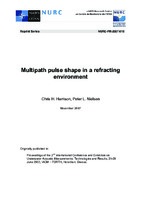| dc.description.abstract | Multiple boundary interactions in shallow water propagation introduce a more or less Gaussian angle distribution at a distant receiver. When all paths are added the result is 'mode-stripping', i.e. the steep rays are stripped away leaving only ray angles near horizontal. Because the steeper, more highly attenuated, rays are also more delayed, the same phenomenon results in a calculable time smearing of an impulse source. It has been shown [Harrison, C.H., J. Acoust. Soc. Am., 114, 2744-2756, (2003)] that in isovelocity water the pulse tail falls off exponentially with a time constant that is dependent only on the derivative of the reflection loss and the water depth and is consequently independent of range. It is therefore a useful geoacoustic inversion tool. Here we investigate the effects of refraction, following a more recent paper [Harrison, C.H., and Nielsen, P.L., J. Acoust. Soc. Am., 121, 1362-1373, (2007)]. Although the leading edge of the pulse is altered, the tail (resulting from steep arrivals) still behaves as in isovelocity water. Results are confirmed by comparisons with C-SNAP. | |
